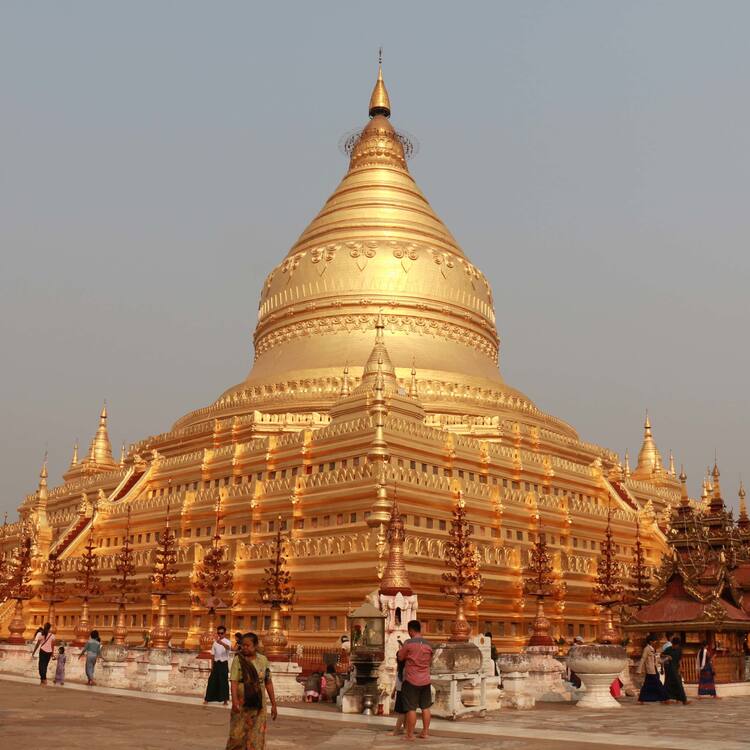Bagan
Bagan
Lying on a bend of the Ayeyarwady River in the central plain of Myanmar, Bagan is a sacred landscape, featuring an exceptional range of Buddhist art and architecture. The seven components of the serial property include numerous temples, stupas, monasteries and places of pilgrimage, as well as archaeological remains, frescoes and sculptures. The property bears spectacular testimony to the peak of Bagan civilization (11th -13th centuries CE), when the site was the capital of a regional empire. This ensemble of monumental architecture reflects the strength of religious devotion of an early Buddhist empire.Description is available under license CC-BY-SA IGO 3.0
Bagan
Niché sur une courbe du fleuve Irrawady, dans la plaine centrale du Myanmar, Bagan est un paysage sacré qui présente un éventail exceptionnel d’art et d’architecture bouddhiques. Composé de sept éléments, le bien compte de très nombreux temples, stupas, monastères et lieux de pèlerinage ainsi que des vestiges archéologiques, des fresques et des sculptures. Il témoigne de façon spectaculaire de la civilisation de Bagan (XIe-XIIIe siècles), quand le site était la capitale d’un empire régional. Cet ensemble d’architecture monumentale reflète l’intensité de la ferveur religieuse d’un empire bouddhique ancien.Description is available under license CC-BY-SA IGO 3.0
باغان
يجسّد موقع باغان مشهداً مقدساً على منحنى نهر إيراوادي في السهول الوسطى في ميانمار، ويقدم للناظرين مجموعة استثنائية من الأعمال الفنية والهندسية البوذية. ويتألف الموقع من ثمانية عناصر، ويحتوي على العديد من المعابد والأبراج والأديرة ومواقع الحج، بالإضافة إلى البقايا الأثرية واللوحات الجدارية والتماثيل. ويقف شاهداً على حضارة باغان (في الفترة الممتدة من القرن الحادي عشر حتى القرن الثالث عشر)، إذ كان الموقع عاصمة إحدى الإمبراطوريات الإقليمية. وتجسد هذه المجموعة المعمارية الضخمة مدى الحماس الديني لدى الإمبراطوريات البوذية القديمة.
source: UNESCO/CPE
Description is available under license CC-BY-SA IGO 3.0
蒲甘
蒲甘坐落在蜿蜒流经缅甸中部平原的伊洛瓦底江畔,是一处欣赏佛教艺术和建筑的圣地。该遗址由8个遗产点组成,内有大量寺庙、窣堵坡、修行所、朝圣地以及考古遗迹、壁画和雕塑。遗产地展示了11-12世纪的蒲甘文明,当时的蒲甘是一个地区王国的都城,这里的成片建筑反映这个早期佛教国家的宗教热情。
source: UNESCO/CPE
Description is available under license CC-BY-SA IGO 3.0
Баган
Расположенный на изгибе реки Иравади на центральной равнине Мьянмы, Баган является «священным ландшафтом», в котором представлено исключительное разнообразие объектов буддийского искусства и архитектуры. Этот объект, состоящий из восьми элементов, включает многочисленные храмы, ступы, монастыри, места паломничества, а также археологические памятники, фрески и скульптуры. Все эти элементы свидетельствуют о расцвете цивилизации Баган (XI-XII вв. н.э.), когда этот объект наследия был столицей региональной империи. Этот монументальный архитектурный ансамбль отражает силу религиозной преданности жителей древнего буддийского царства.
source: UNESCO/CPE
Description is available under license CC-BY-SA IGO 3.0
Bagan
En la llanura central de Myanmar, anidado en una curva de la orilla izquierda del río Irawadi, se halla el sitio sacro de Bagan cuyo paisaje está poblado por un conjunto excepcionalmente abundante y variado de obras artísticas y arquitectónicas budistas. Integrado por ocho elementos, el sitio posee numerosos templos, estupas, monasterios y lugares de peregrinación, así como vestigios arqueológicos, frescos y esculturas. Constituye un testimonio espectacular de la civilización que floreció entre los siglos XI y XIII en la región, cuando la antigua ciudad de Bagan era capital de un importante imperio búdico. El conjunto de monumentos arquitectónicos existentes refleja cuan intenso era el fervor religioso en dicho imperio.
source: UNESCO/CPE
Description is available under license CC-BY-SA IGO 3.0
Outstanding Universal Value
Brief synthesis
Bagan is a sacred landscape which features an exceptional array of Buddhist art and architecture, demonstrates centuries of the cultural tradition of the Theravada Buddhist practice of merit making (Kammatic Buddhism), and provides dramatic evidence of the Bagan Period (Bagan Period 11th – 13th centuries), when redistributional Buddhism became a mechanism of political control, with the king effectively acting as the chief donor. During this period, the Bagan civilisation gained control of the river transport, extending its influence over a large area. The traditions of merit making resulted in a rapid increase in temple construction, peaking in the 13th century. The serial property of eight components is located on a bend in the Ayeyarwady River, in the central dry zone of Myanmar. Seven of the components are located on one side of the River, and one (component 8) is located on the opposite side. Intangible attributes of the property are reflected in Buddhist worship and merit-making activities, traditional cultural practices and farming. The serial property of eight components consists of 3,595 recorded monuments – including stupas, temples and other structures for Buddhist spiritual practice, extensive archaeological resources, and many inscriptions, murals and sculptures. Bagan is a complex, layered cultural landscape which also incorporates living communities and contemporary urban areas.
Criterion (iii): Bagan is an exceptional and continuing testimony to the Buddhist cultural tradition of merit making, and to the peak of Bagan civilisation in the 11th-13th centuries when it was the capital of a regional empire.
Criterion (iv): Bagan contains an extraordinary ensemble of Buddhist monumental architecture, reflecting the strength of religious devotion of an early major Buddhist empire. Within the context of the rich expressions and traditions of Buddhist architecture and art found throughout Asia, Bagan is distinctive and outstanding.
Criterion (vi): Bagan is an exceptional example of the living Buddhist beliefs and traditions of merit making, expressed through the remarkable number of surviving stupas, temples and monasteries, supported by continuing religious traditions and activities. While the evidence of practices of merit-making are common in many Buddhist sites and areas, the influences established in the Bagan period, and the scale and diversity of expressions, and continuing traditions make Bagan exceptional.
Integrity
The integrity of Bagan is based on the ability of the 8 components to convey the Outstanding Universal Value; the material evidence of the landscape, archaeological sites, monuments, inscriptions, sculptures, murals, cloth paintings and the overall setting; the continuing intangible heritage and cultural practices; and the management of pressures on the state of conservation. The integrity is vulnerable due to the multiple factors affecting Bagan, tourism and development pressures, environmental pressures and natural disasters.
Authenticity
The authenticity of Bagan is demonstrated by the landscape of Buddhist monuments of diverse sizes, scales, materials, designs and antiquity; and the rich and continuing religious and cultural traditions. The major built elements within the property, particularly the very large temples and stupas, retain a high degree of authenticity in their form and design, both internally and externally. The decorative elements of many of the individual monuments survive in their original form. The authenticity has been impaired by inappropriate interventions from the 1970s and 1990s, and by the extensive damages that resulted from earthquakes.
Management and protection requirements
Legal protection of Bagan is provided by the newly amended Law for Protection and Preservation of Cultural Heritage Regions No. (20/2019), Protection and Preservation of Ancient Monuments Law 2015 (with updated bylaw 2016), and Protection and Preservation of Antique Objects Law 2015 (with updated bylaw 2016). These laws are administered by the Department of Archaeology and National Museum (DANM). Effective legal protection is dependent on the full implementation of the Protection and Preservation of Cultural Heritage Regions Law. The property is also protected through practices and commitment of the religious communities and local people.
Heritage zoning plans have been established and integrated into regional plans to ensure coordination. A further protective zone of 100 km x 100 km around the property has been established to control development. All developments within the protected zones are currently subject to site-specific archaeological assessment and input from the Department of Archaeology and National Museum (DANM).
The Bagan National Coordinating Committee (BAGANCOM) has been established by the national government as the decision-making body for Bagan, ensuring inter-agency coordination. The main factors affecting Bagan are past conservation interventions, tourism and development pressures, environmental pressures and natural disasters.
The management system is based on the Integrated Management Framework. While some aspects of the management system have recently established, and others are not yet fully implemented, the approach is sound. Guidelines that have been developed to support the most pressing activities. In particular, risk reduction and disaster response have been significantly improved as part of the response to the 2016 earthquake. Further elaboration of the management system should be based on a landscape approach to the management of the serial property.
Some key strategic and policy documents, including the Sustainable Tourism Strategy, Archaeological Risk Plan, Agriculture Sector Strategy and Heritage Impact Assessment System are yet to be completed and/or fully operationalised. The property contains a number of intrusive elements, such as hotels. Rigorous Heritage Impact Assessment and clear decision making processes about development are critically important to the future management of Bagan. A long-term Hotels Strategy that identifies zones where hotels can be developed in the future has been recommended.




